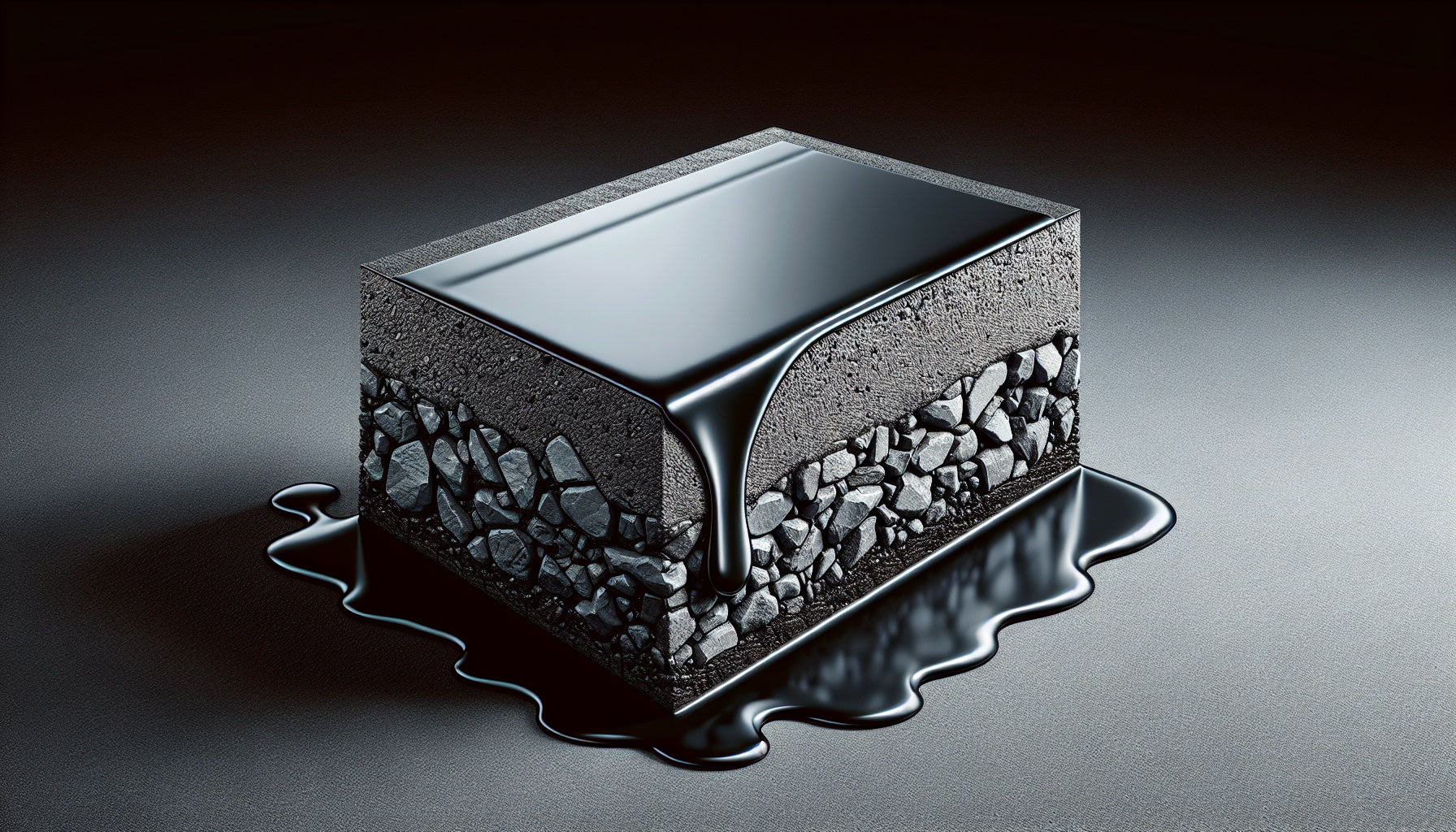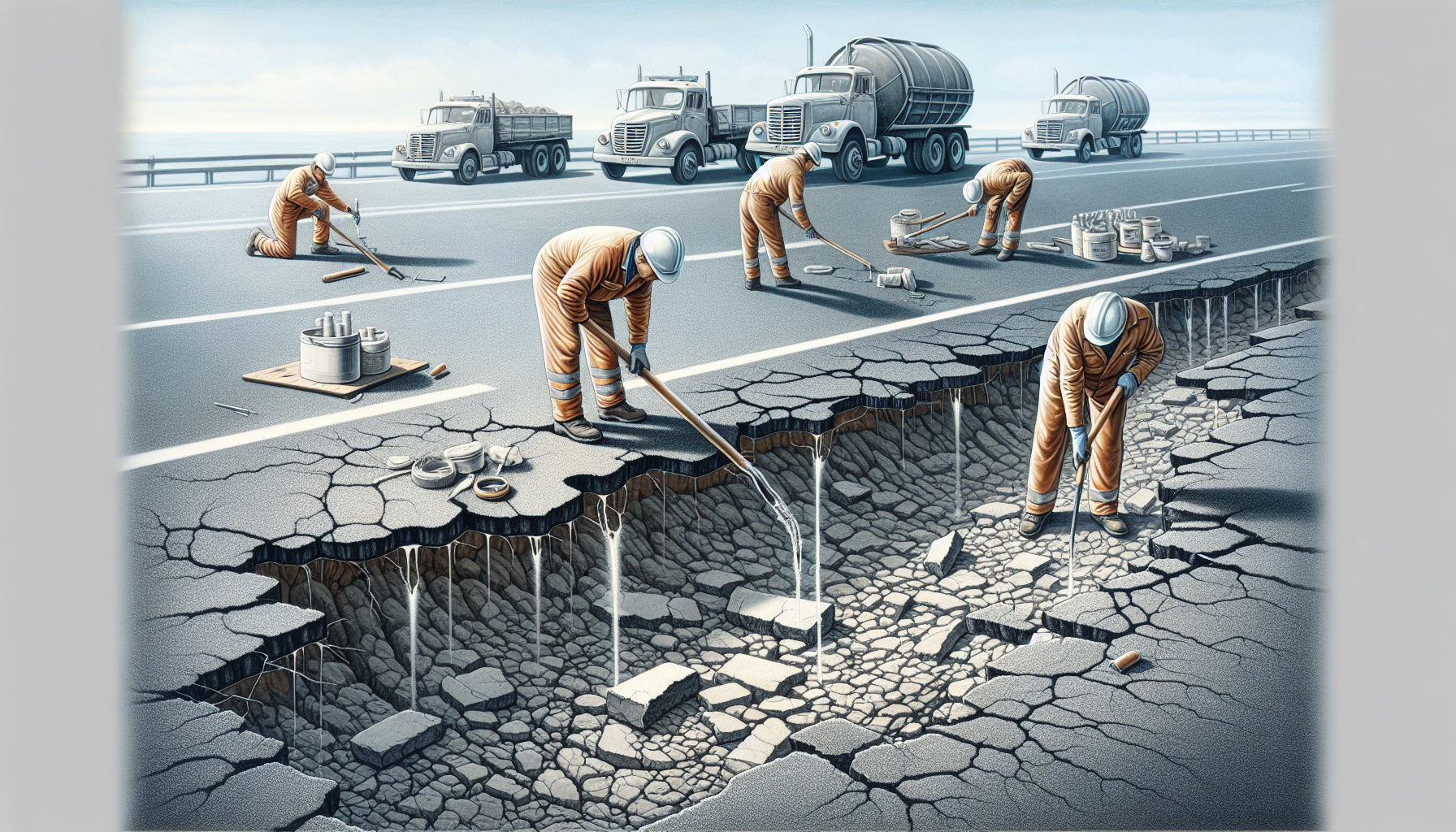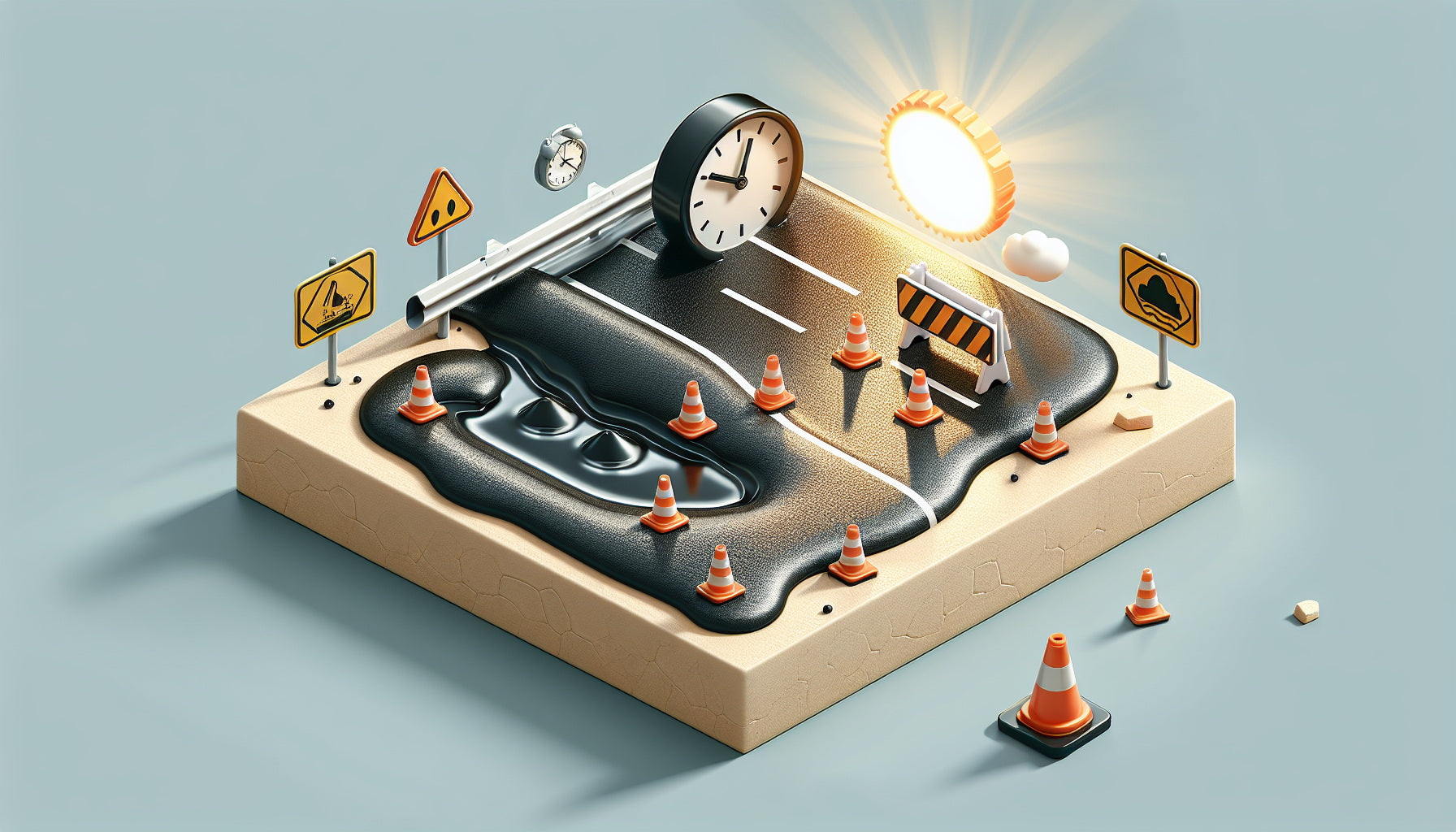Understanding What is Sealcoat and Why it Matters for Your Asphalt
Are you wondering what an asphalt seal coat is and how it can extend the lifespan of your pavement? Look no further. This guide dives into the essential benefits of using a seal coat, such as protecting against UV rays, water damage, and chemical spills, while also offering practical advice on the application process and timing. Whether you’re considering a DIY approach or planning to hire professionals, we’ll provide the insights you need to make an informed decision without the fluff.
Key Takeaways
- Asphalt seal coating acts as a protective layer against UV rays, water, chemical spills, and oxidation, prolonging pavement life and ensuring structural integrity.
- Seal coating is a preventative maintenance measure that enhances pavement durability and appearance, necessitating reapplication every three to five years depending on surface wear and environmental factors.
- Proper timing, surface preparation, including cleaning and crack filling, and choosing the right materials and application methods are crucial for optimal seal coating results and extended pavement longevity.
Understanding Asphalt Seal Coat: A Quick Overview

A seal coating is a pivotal defense mechanism in the arsenal of pavement maintenance, providing a protective shield to fend off deterioration and damage. By applying this specialized layer over an existing asphalt surface, you effectively prolong its life by mitigating the relentless wear from environmental exposure and continuous usage.
Consider the seal coat as a protective mail for your valiant asphalt pavement that repels.
- UV rays
- Water intrusion
- Chemical spills
- Oxidation
Each of these elements can compromise the structural soundness of your pavement if left unchecked.
The Importance of Asphalt Maintenance
The intricate network of our infrastructure is woven together by the essential threads known as asphalt surfaces. These surfaces. Are not immune to the ravages of time and require consistent upkeep. The judicious application of a seal coating serves as a pivotal measure for prolonging the lifespan of your asphalt pavement while circumventing unnecessary expenses on early repairs. Diligent maintenance goes beyond mere cosmetic enhancements. It represents a resolute dedication to maintaining both appearance and integrity of the surface.
Adhering to routine maintenance offers numerous benefits.
- It significantly curtails the emergence of cracks
- It diminishes potential safety risks
- It results in decreased expenditures on repairs over time
- Ultimately, this leads to an aesthetically pleasing and enduringly sound asphalt surface that stands up well into the future.
Seal Coating as Preventative Care
Just as human skin needs sunscreen to guard against sun damage, seal coating acts like a sun protection factor (SPF) for asphalt surfaces. It provides defense against the harsh effects of UV rays, water intrusion, and harmful chemicals. By establishing this protective barrier on the surface, it effectively protects the integrity of the asphalt pavement from discoloration, deterioration and time’s relentless wear.
Applying this revitalizing layer to pavement brings multiple advantages such as:
- Postponing oxidation
- Restoring essential oils
- Preserving pliability
- Halting crack formation
- Preventing brittleness that often emerges with age.
Timing Your Seal Coating
Seal coating is a craft that demands skillful application and precise timing. When it comes to asphalt driveways fresh from installation, waiting 90 days up to an entire year before applying the sealant ensures that all oils have been released and the surface has settled completely, providing a strong and enduring finish. Optimal conditions for seal coating occur when temperatures are between 50–90 °F accompanied by clear skies, as this promotes robust adherence of the coating akin to a firm handshake.
With winter’s chill on the horizon, engaging in early seal coating can safeguard your driveway’s pavement against ice-related damage as well as corrosive agents such as road salt and water—common culprits intent on compromising your asphalt’s integrity.
Identifying When Reapplication Is Needed
The gradual impact of time on asphalt demands constant attention to determine when it’s necessary to renew the seal coat, a crucial protective layer. Speaking, sealing is advised every three to five years. Indicators such as graying, discoloration and cracking could necessitate more immediate action.
As cracks begin to fragment the surface of your asphalt and crumbling ensues, understand this is more than an appeal for cosmetic repair—it’s an urgent call for its preservation. Responding promptly with a fresh seal coat can prevent Deterioration that may otherwise significantly diminish the lifespan of your asphalt.
Preparing Your Asphalt for Seal Coating

Prior to the application of seal coating, it is crucial that the asphalt surface undergo meticulous preparation to ensure optimal outcomes. This entails a detailed examination, akin to a sleuth’s scrutiny, searching for any crevices, sinkholes or flaws which might undermine the efficacy of the sealant. The adhesion of the seal coat can only be assured when every trace of everyday grime—be it dust, dirt or oil—is completely eradicated from the asphalt surface.
Addressing all detected imperfections by carefully packing them with suitable crack filler sets up an ideal foundation ready for the critical application of seal coating.
Cleaning the Surface
The successful application of a seal coat begins with an impeccably clean asphalt surface. Every trace of sand, dirt, and residue from daily wear must be meticulously removed to promote the strong bonding of the protective coating. Whether utilizing a simple garden hose or deploying a powerful pressure washer, eliminating oil and debris is essential for achieving a long-lasting seal.
As if under the watchful eye of the sun, it’s imperative to recognize that preparing the surface through cleaning is just as important as applying the sealing material itself. Because only when an asphalt surface is thoroughly purified can one expect to attain a protective coating capable of enduring both time and weather conditions without faltering.
Crack Filling: The First Line of Defense

Employing rubberized crack filler to seal small cracks in the pavement acts as a crucial preventative measure against the progression of surface damage. This type of crack filler is selected for its ability to adapt to thermal changes, offering robust sealing akin to an impenetrable barrier that effectively secures minor fissures and openings.
This process goes beyond being a simple task. It’s an essential element in maintaining the structural integrity of asphalt pavements. By addressing each individual crack, we safeguard against more significant issues developing over time while preparing the surface for subsequent application of a seal coat—a vital shield from wear caused by vehicles and environmental elements.
Tack Coat: Ensuring Adhesion
The adhesive qualities of the tack coat are pivotal in fortifying the connection between the new sealant and existing asphalt. Like a meticulous painter, it is applied as liquid asphalt to form an adherent base that ensures the seal coat firmly attaches.
Adhering faithfully to uniform application, this tack coat guarantees that the sealant bonds uniformly across the entire surface. Such even adhesion leads to a blend of layers that support one another, ultimately producing a pavement surface that combines aesthetic unity with enhanced durability.
Applying Asphalt Sealant: Techniques for Best Results
The key to perfecting seal coating is rooted in expertise and meticulous attention. For successful sealing, it’s important to be as precise and committed as an experienced artisan. Here are some essential guidelines:
- Monitor the weather closely, choosing a day that provides ideal temperatures and humidity for application.
- Apply the correct quantity of sealer by adhering strictly to the recommendations provided by its manufacturer.
- Address any necessary crack repairs before moving on with applying your coat of sealer.
- Thoroughly clean the area beforehand, ensuring no remnants of oil stains or dirt remain.
Adhering to these strategies guarantees a professionally executed seal coating job with endurance.
Attention to minute details sets apart superior workmanship: using barriers along boundaries can achieve precision lines while ensuring uniformity throughout — both visually satisfying and structurally reliable. The objective isn’t merely distributing a coat over an area. Rather it’s about constructing a steadfast protective layer through diligent effort that underscores one’s unwavering dedication towards excellence in quality craftsmanship.
Choosing the Right Materials
Choosing the appropriate material for sealing, such as a blacktop sealer, is not a simple matter, but one that requires thorough consideration of the specific requirements and state of the pavement. Sealants derived from coal tar are highly regarded in protecting asphalt driveways because they offer exceptional durability, whereas acrylic sealers provide adaptability and quick-drying advantages for concrete surfaces.
Among the choices available for sealing products are:
- Acrylic sealers based on solvents provide an optimal blend of performance and affordability.
- Sealers made with asphalt emulsion are favored by property owners who prioritize environmental responsibility when it comes to residential driveways.
- Quick-dry sealants prove essential for business areas where downtime must be minimized and speedy restoration of service is crucial.
The Application Process
Applying an asphalt emulsion sealant to pavement is akin to painting a masterpiece, where the choice of tool—be it squeegee, brush or roller—can distinctly affect the final appearance. Adhering to the principle that “less is more,” adding a second coat enhances both its resilience and defense against natural forces, leaving evidence of meticulous care on the property.
When approached without expertise, DIY efforts can lead to patchy sealing and subpar protection. With adept application and careful timing, one can achieve a lustrous surface that stands as proof of diligent workmanship while offering sustained resistance against the relentless progression of time.
Drying Time and Traffic Management

It is critical to exercise patience for the sealant drying process in order to achieve optimal quality. A waiting period of 24 to 48 hours is necessary before vehicles can resume their movement over the asphalt surface, with a recommendation of a full 48-hour duration for complete cure. If weather conditions include high humidity or cloud cover, this time frame might need an extension up to a minimum of three days (72 hours) so that everything is perfectly prepared for vehicular activity.
In commercial settings where every moment counts, quick-drying sealants are available as an expedient alternative—shortening downtime and quickly revitalizing parking lots for business use. While the newly applied sealant on the parking lot cures, pedestrian access may be permissible just a few hours after application if conducive temperature from sunlight is present. To ensure undisturbed curing and maximum effectiveness of protection, brightly colored warning tapes can be strategically placed around treated areas acting as barriers against vehicle traffic during this crucial phase.
Enhancing Curb Appeal and Property Value

The attractiveness of a well-kept asphalt surface extends beyond its appearance, improving both the value and curb appeal of any property it enhances. A new seal coat delivers multiple advantages, such as:
- An even and sleek finish
- Increased strength and extended service life
- Defense against elements like weathering and oxidation
- Strengthened defense to spills from oil and gasoline
- Enhanced safety due to better traction underfoot
- An efficient option for preserving the asphalt
More than just an aesthetic improvement, applying a fresh seal coat creates a positive lasting impression on those who visit or simply pass by.
In the competitive realm of real estate transactions, maintaining an immaculate asphalt driveway can augment a property’s worth by as much as 7%, which is indicative of significant investment returns that highlight the importance of consistent upkeep with regard to asphalt surfaces. The state in which one’s driveway is kept often mirrors the overall attention paid to maintenance throughout their premises—thus affecting prospective buyers’ impressions—and firmly establishing its fiscal standing within the market.
Professional vs. DIY Seal Coating
Opting for a professional seal coating service or choosing to do it yourself is essentially weighing the value of expertise against personal control. Engaging experienced professionals means you get access to top-quality materials and the reassurance provided by guarantees on their work. While this option might require higher initial investment, the long-term benefits that come with a professionally applied coating—characterized by its durability and extended lifespan—are likely to lead to significant savings over time.
On the other hand, taking on a DIY project allows owners complete oversight of their undertaking as well as potential reductions in labor expenses, though at the expense of time commitment and possibly inferior results. Those who have ample time may be drawn toward doing it themselves due to an attraction towards direct involvement in projects and achieving satisfaction from personally completed tasks which could make self-applying seal coat appealing despite possible drawbacks.
The Economic Benefits of Regular Asphalt Sealing
Opting to seal an asphalt surface extends beyond mere appearance. It is a matter of economic foresight. Applying a regular coat of seal every two or three years serves as a safeguard against the significant expenditures associated with major repairs and overhauls that can accumulate throughout the lifespan of the pavement. In this light, maintaining an asphalt surface through routine sealing should be regarded not as an outlay but rather as a cost-effective measure—one that protects against the unforeseen expenses arising from neglect.
The cost involved in such preventive care fluctuates based on various factors including pavement dimensions, its current state, and regional variations in workforce and material prices. When set aside from the imposing financial demands potentially imposed by thorough renovations or total replacements, consistent application of sealcoat stands out as judicious management—a preferable choice for asset preservation.
Advanced Seal Coating Options
For those in search of top-notch pavement preservation, innovative sealing methods such as slurry seal offer a robust remedy for deteriorating surfaces. With the addition of polymers, these treatments rejuvenate asphalt’s pliability and impart to it an enhanced look, perfectly suited for residential roads in need of renewal.
Specialized trucks are utilized to apply the slurry seals evenly across pavements that display early signs of aging yet lack deep ruts or wide cracks. This sophisticated process can quickly revamp a fatigued surface into a durable pathway equipped to withstand the rigors imposed by both traffic and time within just hours.
Kevin King's Expert Insights
Kevin King stands at the forefront of asphalt maintenance, leveraging extensive practical experience. His establishment of Asphalt Industrial has cemented his expertise not only in the upkeep of asphalt surfaces but also in choosing optimal equipment for various tasks such as applying sealer and filling cracks.
His recommendations and guidance are grounded in real-world know-how, providing both property owners and maintenance experts with a wealth of knowledge. When Kevin discusses seal coating, he offers not simple conjecture but informed advice honed through years spent mastering the ups and downs inherent to preserving asphalt.
Summary
As we journey through the domain of asphalt preservation, it becomes clear that seal coating is not a mere procedure, but a pivotal element in the lifecycle of any pavement. From the initial understanding of its purpose, through the meticulous preparation and application processes, to the economic and aesthetic benefits, each step is a stitch in the fabric of longevity.
Embrace the lessons imparted, the insights from industry experts like Kevin King, and recognize the profound impact that regular, expertly executed seal coating can have on your asphalt surfaces. Let this guide inspire you to take action, safeguarding the paths that bear the weight of our daily travels, and in doing so, ensure that the value and appeal of your property are as enduring as the pavement itself.
Frequently Asked Questions
Is seal coating asphalt worth it?
Indeed, applying seal coating to asphalt proves valuable because it hinders the process of oxidation and inhibits crack formation. This contributes to a decreased chance of pothole development, thus maintaining road safety and aesthetic appeal over an extended duration.
How often should I seal coat my asphalt driveway?
You should generally reapply seal coating every three to five years.
Keep an eye out for signs of wear like graying, discoloration, or surface cracks.
Can I apply a seal coat to new asphalt immediately?
Applying a seal coat to new asphalt should ideally be postponed for 90 days up to one year following installation. This delay ensures that the asphalt has adequately settled and that any oils have been released.
What are the best conditions for seal coating?
Optimal conditions for applying seal coating include temperatures ranging from 50 to 90 degrees Fahrenheit and a minimum period of two continuous days without rain to ensure the proper bonding and drying of the coating.
Should I hire a professional or can I seal coat my asphalt myself?
Enlisting the services of a professional for your asphalt seal coating is advisable as they bring to the table not only their skill and proficiency but also premium materials along with guarantees of service that contribute to enhanced results over an extended period.
Making this investment is justified considering the exceptional quality of outcome it delivers.



2 comments
Hi,
All sand used should be clean, dry, pure silica sand, free of contaminants. Medium fine sand with an A.F.S. rating of 50 to 70 gives the best results. There should be no more than 2% retained on 30 mesh or coarser, no more than 10% retained on 140 mesh and no more than 0.3% retained on 200 mesh.
Please note: Sealer with sand mix is only compatible with air-operated spray systems.
Kevin
Really enjoyed your interesting article on seal coatings. Although I am not in the market for any asphalt to be sealed, my interest in seal coatings is peaked because I work for a company which supplies substrate to the seal coatings business. If I might ask you a question what is the best size of sand grain to broadcast onto seal coat to enhance slip resistance. We sell to some companies which use a 40 mesh thru 140 mesh product. I am not sure whether this grade is optimal or not as a grip enhancer. If you could shed some light on this I would be appreciative.
Thanks
Paul Salt